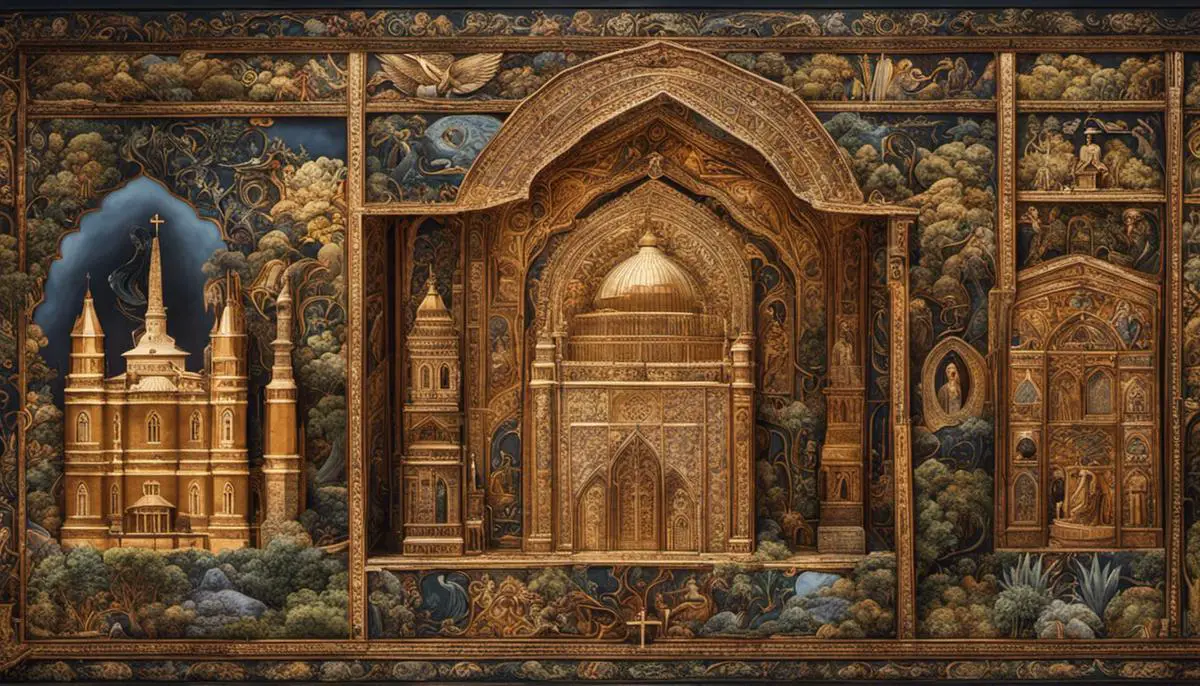Australia, the world’s smallest continent yet the sixth largest country, is known for its rich biodiversity, stunning landscapes, and most importantly, its diverse populace. This diversity is spread across various aspects such as ethnicity, religion, language, age, gender, and socioeconomic status. The country’s demographic richness paints a vivid picture of a melting pot of cultures, ages, languages, and religions, along with a broad spectrum of socioeconomic statuses. With its unique blend of indigenous heritage and immigrant influences, Australia showcases an evolving identity that is as diverse as it is united.
Ethnic and Cultural Diversity
Ethnic and Cultural Diversity in Australia
Australia is known for its high level of cultural diversity, with individuals hailing from a myriad of different ethnic and cultural backgrounds. According to the Australian Bureau of Statistics in 2021, about 30% of the Australian resident population were born overseas, demonstrating a considerable presence of immigrants in the country. A major share of these foreign-born residents hail from countries such as England, China, India, New Zealand, and the Philippines, contributing substantially to Australia’s rich cultural tapestry.
The Indigenous Australian Population
Australia’s indigenous population, including Aboriginal and Torres Strait Islander people, also constitute a significant part of Australia’s cultural landscape. As per the 2016 Census, around 3% of Australia’s total population is composed of Indigenous Australians, while the 2021 mid-year estimates suggest a slightly higher figure of about 3.3%.
The cultural practices, languages, and belief systems of Indigenous Australians, comprising over 250 language groups, contribute significantly to the overall diversity and multicultural fabric of Australia. Torres Strait Islanders, for instance, with their distinct set of customs and characteristics, enrich Australia’s social and cultural milieu.
Multiculturalism as Australia’s Identity
Multiculturalism is at the core of Australia’s identity, fostering a social environment that respects and celebrates cultural differences. The Multicultural Australia: United, Strong, Successful policy launched in 2017, asserts that multiculturalism has been instrumental in shaping modern Australia.
Despite this emphasis on multiculturalism, issues of racial and cultural discrimination persist. According to the Australian Human Rights Commission’s 2015 National Survey, approximately 20% of Australians experienced discrimination based on their race. Cultural diversity is certainly something to be celebrated in Australia, but it also leads to the challenge of achieving social cohesion.
Language Diversity
Alongside ethnic diversity, Australia also exhibits strong linguistic diversity. English remains the dominant language, but other languages like Mandarin, Arabic, Cantonese, Vietnamese, and Italian also have considerable numbers of speakers. In fact, the 2016 Census revealed that nearly 22% of Australians speak a language other than English at home, a figure anticipated to rise in light of ongoing immigration.
Religious Diversity
Australia also emerges as a religiously diverse nation. While Christianity remains the most widely practiced religion, other religions like Islam, Buddhism, Hinduism and Sikhism have notable representation. As per the 2016 Census, around 30% of Australians reported having no religion, indicating a growing secular trend in recent times.
Overview
Australia is recognized for its vibrant mix of different ethnicities, cultures, languages, and religious beliefs, distinguishing it as one of the world’s most diverse countries. Crucially though, while we celebrate this diversity, it’s vital that we are aware of and work towards addressing the ongoing discrimination issues in order to continue upholding social harmony and equality.

Religious Diversity
The Multicultural Picture of Religion in Australia
One significant aspect of Australia’s ethnic diversity manifests in a broad spectrum of religious practices and beliefs. Census data reveals that the significant majority of Australians, about 52.1%, identify themselves as Christians. This broad group includes subgroups such as Catholics (22.6%), Anglicans (13.3%), and followers of other Christian denominations (16.2%).
Australia’s Religious Minorities
While Christianity has a significant presence, the island continent also provides a home to a myriad of religious minorities. After Christianity, the largest religious affiliations in Australia are Islam (2.6%), Hinduism (1.9%), and Buddhism (2.4%), with a notable proportion of Australians (8.2%) preferring to follow other varied religions or not specifying their religious affiliation.
The Rise of Non-Religious Australians
Interestingly, there has been an observable shift in the religious demography of Australia. Key census findings indicate a growing trend of Australians moving away from organized religion, with almost a third (30.1%) of the population identifying as having no religion. This trend is particularly prominent among younger Australians, echoing global trends of secularization.
Sectarian Distribution among Younger Generations
Furthermore, a closer observation into the religious landscape of younger generations in Australia uncovers a remarkable diversification. While the majority still identifies as Christian, there appears to be an increasing interest in non-Abrahamic religions such as Hinduism and Buddhism, as well as atheism and agnosticism.
Changing Trends and Future Projections
Continuing shifts in religious beliefs could result in changing demographics within the next few years. The proportion of people identifying as Christian has been slowly but consistently decreasing over the past few decades, and this trend is anticipated to continue. At the same time, the number of people identifying with non-Christian religions, particularly Islam and Hinduism, has been on the rise. This pattern suggests that Australia’s religious diversity is expected to increase even further in the future, reflecting its cultural mosaic.
Gender and Region Specifics
The Australian Bureau of Statistics also provides interesting insights on the geographic and gender-specific distribution of religious beliefs. For instance, Buddhism is more commonly practiced in the major cities on Australia’s east coast, while Christianity is more prevalent in regional areas. In terms of gender, there is a slightly higher percentage of men who report having no religion compared to women.
Ultimately, Australia celebrates a harmonious and pluralistic society that embraces a wide array of religious beliefs. Despite evolving trends and emerging patterns in religious affiliations, the country’s escalating religious diversity is a testament to its multicultural core. This aspect is regularly evidenced in nationwide census data.

Linguistic Diversity
The Multitude of Languages in Australia: An Emblem of Diversity
Australia serves as a home to a multitude of languages, reflecting its vibrant multicultural society. As per the 2016 Australian Census of Population and Housing, over 300 languages were reported as a person’s primary language spoken at home. English remains predominant, with approximately 73% of the population registering it as their first language. However, a significant segment of the population speaks languages that are not English, demonstrating Australia’s immense linguistic diversity.
Households where non-English languages are spoken are a prominent trait of multicultural Australia. Data from the 2016 Census disclosed that roughly 26% (or over 6 million individuals) of the population used a language other than English at home. This segment primarily features individuals from China and India. After English, Mandarin, Arabic, Cantonese, Vietnamese, and Italian were listed as the top five most prevalent languages spoken at home.
Recent years have witnessed a continuous growth in the percentage of people speaking a language other than English in Australia. This surge can be largely attributed to the country’s dynamic immigration policies that welcome residents from diverse ethnic backgrounds, thereby perpetually enriching Australia’s linguistic diversity.
Impact of Linguistic Diversity on Australian Society and Culture
The profound effect of this linguistic diversity is clearly seen in the nuances of Australian society and culture. In regions with high populations of non-English speaking households, there is a marked shift in local businesses, who adjust their services to accommodate these language groups. This adaptation is especially prevalent in major cities like Sydney and Melbourne, which boast a notable continuance of Mandarin and Cantonish speakers, evidenced by the prevalence of newspapers, radio stations, and television programming in these languages.
Furthermore, this richness in language diversity positively impacts Australian society by nurturing an understanding and acceptance of various cultures. It offers a platform for dialogue and perspectives, contributing to a lively, vibrant, and inclusive cultural landscape. A glimpse of this social influence is seen in the school systems, where language instruction spans an array of languages, promoting students’ understanding of diverse cultures and encouraging appreciation for cultural diversity.
Linguistic diversity also holds implications for Australia’s international relations, as residents who speak languages other than English often serve as a conduit between their native countries and Australia. This connection can potentially strengthen diplomatic and commercial relationships.
Lastly, the richness of linguistic diversity breathes life into the Australian literary and artistic scenes. Works by authors and artists from non-English speaking backgrounds bring unique narratives and perspectives, enriching Australia’s literary and arts sector.

Age and Gender Diversity
Demographical Age Diversity in Australia
Australia is recognized for its diversity, which extends to the age demographics. Data from the Australian Bureau of Statistics (ABS) as of September 2020, points to a median age of 37.4 years for the Australian population, indicating a slight aging trend over the past two decades. To put this in perspective, in 2000, the median age stood at 35.9, and a decade later in 2010, it was 36.9 years.
Interestingly, the age distribution across Australia isn’t uniform and reflects regional disparities. Tasmania, for example, has the highest median age at 42.4 years, whereas the Northern Territory features the youngest median age at just 33.3 years. This range in age distribution mirrors the economic, cultural, and lifestyle contrasts that span the breadth of this extensive country.
Gender Diversity in Australia
In terms of gender diversity, the ABS also provides segmented data. The overall sex ratio in Australia at the end of 2020 was 98.7 males per 100 females, accounting for approximately 12.6 million males and 12.8 million females. The gender distribution, like age distribution, varies across different states and territories.
The Northern Territory was the only region that had more males than females, with 108 males for every 100 females. However, the Australian Capital Territory showed a slight skew towards female population with a ratio of 97.1 males per 100 females.
Demographic Composition: Age and Gender
Upon analyzing the age and gender distribution in Australia, interesting patterns appear. Census information confirms that women marginally outnumber men across the country, with an exception observed in the under 15 age group where boys are subtly more prevalent. An additional disparity is observed in the 25-29-year-old group, recording a higher number of men likely due to a surge in young male immigration.
However, for the older demographic, specifically those aged 85 and above, women significantly surpass men with a ratio of 65 men per 100 women. This difference is a direct reflection of women in Australia generally having a longer life-expectancy than men.
Overall, the diversity in age and gender distribution in Australia illustrates varied demographic characteristics that notably differ across its various regions.

Photo by ninastrehl on Unsplash
Socioeconomic Diversity
The Spectrum of Socioeconomic Diversity
Diving deeper into the social structure, Australia holds a broad socioeconomic diversity that fluctuates across the entire nation. According to a 2021 report published by the Australian Council of Social Service (ACOSS), there is a distinct polarization in wealth distribution, with the richest 20% of households controlling over 60% of the total household wealth.
Contrastingly, the economic distribution is skewed so dramatically that the least wealthy 20% of the population claim only 1% of the entire wealth pool. This significant inequality in wealth distribution has extensive ramifications on each individual’s experience and opportunities, and inevitably influences their quality of life, resource accessibility, and potential mobility.
Education Levels and Employment Rates
The Australian Bureau of Statistics (ABS) offers a clear picture of diversity in education and employment. As per the ABS, approximately 26% of Australians aged 15 and over have a Bachelor’s degree or above. Victorian residents have the highest proportion of people with a bachelor’s degree or above, at roughly 31%. Employment rates in Australia have been largely stable over the last decade, with the overall unemployment rate staying below 7% prior to the COVID-19 pandemic. However, these figures also underline the inequality across different population groups. For instance, unemployment rates among aboriginal and Torres Strait Islander people are almost three times those of non-Indigenous Australians. The rates are higher in the most disadvantaged areas, with people with low educational attainment and older workers facing the most barriers in finding employment.Implication on Healthcare
The uneven distribution of wealth and education in Australia has significant implications for healthcare. Socioeconomic status can influence individuals’ experiences of healthcare, including access to and quality of care. Data suggests that people from lower-income households are more likely to skip medical care or treatments due to cost. They experience higher rates of chronic illness and lower life expectancy compared with wealthier individuals. This highlights the need for investments in healthcare services tailored to cater to the specific needs of people from diverse socioeconomic backgrounds.Education and Social Development
Diversity in wealth and education levels also affects education and community development. Educational achievement is often linked with socioeconomic status – children from low-income households are more likely to leave school earlier, have lower literacy and numeracy skills, and are less likely to go on to tertiary education. In terms of community development, neighborhoods with high levels of poverty often grapple with issues like crime, inadequate housing, and lack of necessary facilities, ultimately affecting the overall well-being of the community. Exploring initiatives to improve wealth distribution, educational opportunities, job placements, and affordable housing could aid in improving societal well-being across Australia.
Australia’s ethnic, religious, linguistic, age, gender, and socioeconomic diversity is truly a reflection of a vibrant, globalized society. This diversity, complex yet harmonious, has given rise to an ever-evolving multicultural nation with a spirit of inclusivity and tolerance. As it continues to embrace and manifest diversity in every aspect, Australia serves as an inspiring testament to cultural symbiosis and social evolution. Thus, understanding and appreciating Australian diversity, whilst also acknowledging the challenges it poses, is key to fostering an environment of respect, equality, and progress in the society.






